What Is An Acoustic Guitar? In this article for beginners, we explain: what an acoustic guitar is; the difference between acoustic guitars and other types of guitar; what you can do with an acoustic guitar; and how it is played.
What Is An Acoustic Guitar?
- An acoustic guitar is a guitar with a hollow body that amplifies the vibration of the strings acoustically.
- An acoustic guitar doesn’t require external electronic amplification in order to be comfortably heard.
- The vibrations of the strings of an acoustic guitar are amplified via the ‘sound box’ (the hollow body of the guitar) and the ‘sound board’ (the front of an acoustic guitar’s body).
- The term 'acoustic guitar' generally refers to a guitar with steel strings.
Acoustic-Electric Guitars
Some acoustic guitars are fitted with electronics that enable them to be ‘plugged in’ to an amplifier. These guitars are known as acoustic-electric (or electro-acoustic) guitars. You can find out more about them further down the page.
Acoustic Guitars Have Steel Strings.
The term ‘acoustic guitar’ is usually used to refer solely to steel-string guitars. Although classical guitars also produce sound acoustically without any need for amplification, they are strung with nylon strings.
(See further down the page for more information on the differences between acoustic and classical guitars.)

A standard acoustic guitar has six strings. Twelve string guitars are available – these have a rich sound but are usually only used for strumming chords. You may find what you can do with a 12 string guitar rather limiting.
In standard tuning, the strings of an acoustic guitar are tuned to the pitches E, A, D, G, B, E.
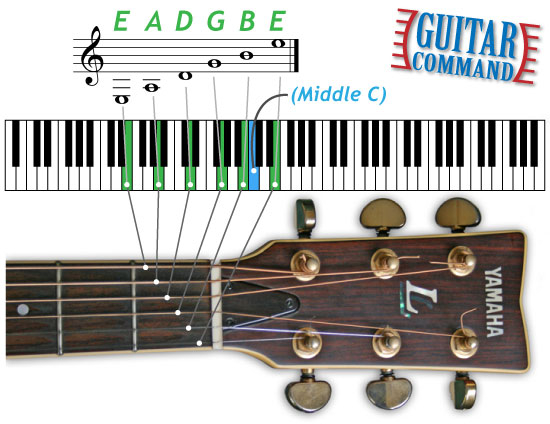
Other tunings are used, including ‘Drop D’, in which the lowest string is tuned down to a D, and ‘DADGAD’, named after the pitches the strings are tuned to.
What Does An Acoustic Guitar Sound Like?
Acoustic guitars have a characteristically bright, metallic sound.
A guitar's sound varies in tone depending on: the wood the guitar is constructed from, what strings are used, whether the guitar is played with the fingers or a pick, and how / where the strings are sounded.
Watch the incredible video further down the page to hear what an acoustic guitar sounds like!
Spruce Vs Cedar Acoustic Guitars?
Acoustic guitars usually have 'tops' (i.e. the front of a guitar, where the sound hole is) made from either spruce or cedar. Cheaper instruments tend not to have solid tops, and are instead made from laminates.
In general, spruce guitars have a brighter sound than cedar guitars. Cedar guitars produce a mellow, warm sound.
Spruce guitars are generally yellow-gold in appearance, whereas cedar guitars have a more reddish color.
Which is best depends on your own personal preferences. Try several different types to hear which suits your own style of playing.
What is an Acoustic Guitar: Fingers or Pick?
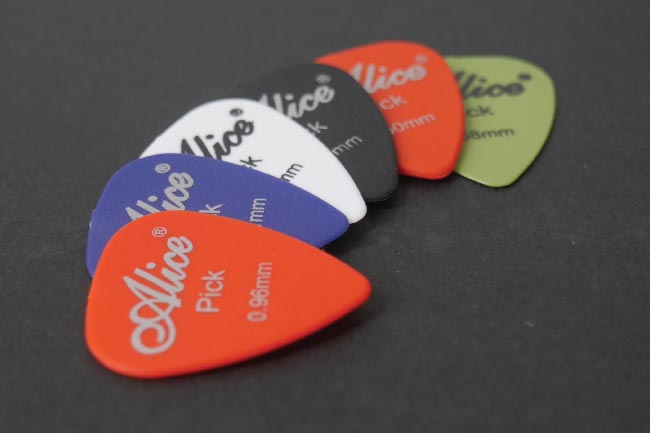
A pick (also known as a plectrum) is a rounded triangular piece of plastic that is used to strike the strings of the guitar. Playing with a pick produces a louder and clearer tone than playing with the fingers.
However, when using a pick it's only possible to play single or adjacent strings at the same time.
Solo acoustic guitarists (i.e. those who play solo guitar music on their guitar rather than accompanying singers or other musicians) usually use their fingers to sound the strings. They often grow the fingernails of the picking hand to improve clarity and volume.
You'll find out more about guitar playing styles further down the page.
Which Hand Does What?
Right-handed guitarists (and guitarists who write with their left hands but play guitar in a ‘right-handed’ fashion) sound the strings with their right hands – either by using a pick, or with the fingers or thumb.
The fingers of the other hand (i.e. the left hand for most guitarists) are used to hold down the strings at the correct fret on the fretboard (the front of the ‘neck’ of the guitar). This causes the strings to vibrate at the required pitch.
What Is An Acoustic Guitar Used For?
Although traditionally the acoustic guitar is most closely associated with folk music, today it is used in all kinds of popular music, from jazz through to rock.
- If you see a solo singer / songwriter accompanying themselves with a guitar, then they'll usually be playing an acoustic guitar.
- If you hear a guitar being ‘strummed’ (you can find out what ‘strumming’ is further down the page) in a song, then unless the song is Spanish or Latin American in style, you’ll probably be listening to an acoustic guitar. (Classical guitars tend to be more commonly used in Spanish or Latin American music.)
How to Play an Acoustic Guitar: Playing Styles
The acoustic guitar can be played in a number of ways, either to provide accompaniment for other musicians, or as a solo instrument.
Strumming Chords
The most common way of playing an acoustic guitar is to strum chords. (A chord is simply a group of notes that sound together at the same time.)
Strumming involves chords being played in a rhythmic manner in order to accompany a singer or other musician(s).
The notes are sounded (almost) simultaneously by striking the strings with a sweeping downward or upward movement of the hand.
Flatpicking
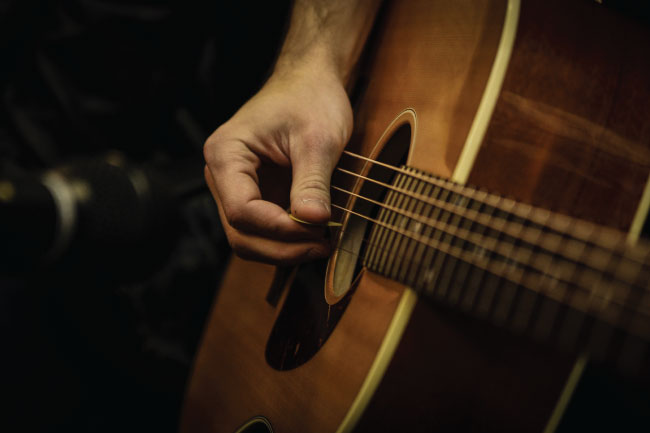
Flatpicking involves playing the guitar with a pick in order to produce music that is more complex than that produced by strumming chords.
In flatpicking, single notes and chords are played in often quite elaborate patterns. In this way, a single flatpicking guitarist is able to create the effect of a melody and accompaniment in one. The acoustic guitar can be played solo in this way.
Fingerstyle
In fingerstyle acoustic guitar playing, the notes of chords and melodies are sounded with the fingers rather than with a pick.
This allows greater control over which notes are sounded at the same time. A single fingerstyle guitarist can play the bass notes, chords and melodies of a piece of music at the same time, thereby producing a complete solo performance.
The video below shows some awesome fingerstyle guitar playing:
Both flatpicking and fingerstyle can also be used to provide accompaniment for other musicians / singers.
Acoustic Vs Acoustic-Electric
Acoustic-electric guitars (sometimes known as electro-acoustic or electric acoustic guitars) are acoustic guitars with built-in electronics that enable them to be connected to an amplifier or sound system.
This is useful for situations in which the acoustic volume of the instrument is insufficient (e.g. when playing in a noisy bar, or in a band that includes electric instruments & a drummer).
In an acoustic-electric guitar, the vibrations of the strings are converted into electrical current by a device called a ‘pickup’. Most acoustic-electric guitar pickups are ‘piezo’ pickups, which rely on crystals to convert the physical vibrations of the strings into electrical signals.
Acoustic Guitar Vs Classical Guitar?
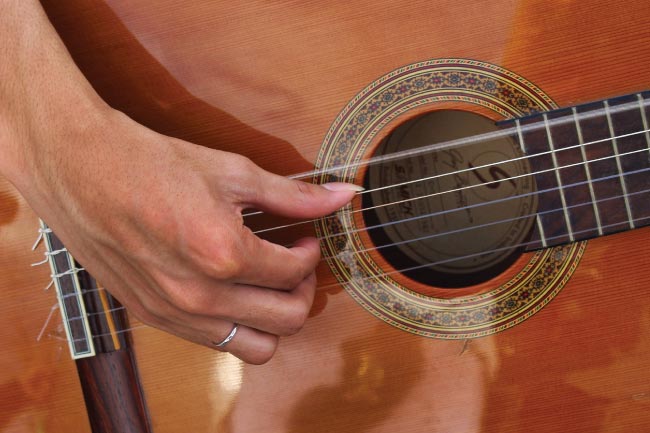
Classical guitars (also known as ‘Spanish guitars’) are outwardly similar to acoustic guitars. However, classical guitars are strung with nylon, rather than steel, strings. They have a warmer, fuller tone, and are used to play classical music, as well as music of Spanish or Latin origin.
You can find out more about classical guitar playing here: Learning Classical Guitar.
Acoustic Guitar Vs Electric Guitar

Electric guitars are designed to be used with external amplifiers. They are usually fitted with magnetic pickups which convert the vibration of the strings into an electric current. They are connected to an external amplifier with a guitar lead.
Most electric guitars have solid bodies with no resonating chamber. They produce only a very quiet, tinny sound when played unamplified.
The basic sound of an electric guitar can be modified greatly with various electronic devices.
Although electric guitars can be played fingerstyle, they are generally played with a pick. Electric guitars are rarely played solo; an electric guitarist is usually a member of a band or other ensemble.
Electric guitars are easier to play for a beginner – less physical effort is required to hold down the notes in order for them to sound cleanly.
There is a large overlap in what can be done with acoustic and electric guitars. However, if you want to play rock music in a band, then get an electric guitar. If you want to accompany yourself singing, to play in an acoustic band, or to play solo folk-style music, then get an acoustic.
The notes, and to some extent the playing style, is the same for both instruments, and most guitarists are able to play both types of guitar.
Acoustic Guitar Vs Semi Acoustic Guitar?
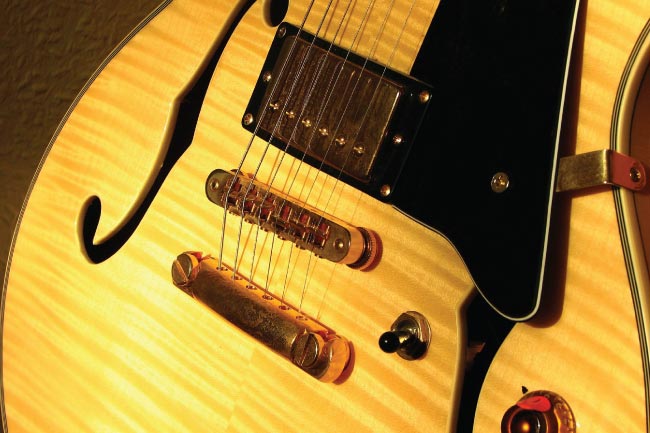
A semi-acoustic guitar is closer to an electric guitar than an acoustic guitar. It is basically an electric guitar with a hollow body. This gives the instrument a warmer tone.
What You’ll Need to Get Started on Acoustic Guitar
Of course, the main thing you’ll need is an acoustic guitar! Get the best one you can afford; annoyingly, higher-end (i.e. more expensive) guitars are often easier to play than cheaper instruments.
This isn’t always the case, however, and some inexpensive, mass-produced guitars are extremely playable. Seek the advice of a guitar-playing friend of guitar teacher.
As well as the guitar itself, we recommend that you invest in a guitar tuner – this will make tuning so much easier, and save yourself lots of time that could be better spent playing!
A metronome will also come in handy as you get to grips with playing in time.
What is an Acoustic Guitar? Conclusion
We hope that after reading this article that you now have a better idea of what an acoustic guitar is, and also how it compares to other types of guitar.
If you plan on teaching yourself how to play the guitar, then there are a number of excellent tuition books available to help you. You can see a collection here: Best Guitar Books.
If you don’t want to go down the traditional guitar teacher route, you can now get excellent online guitar tuition. This gives you the flexibility of learning at your own pace and fitting your lessons around your existing lifestyle. Check out JamPlay for details of their acoustic guitar courses.


